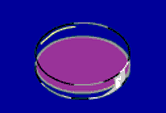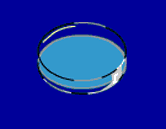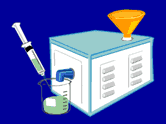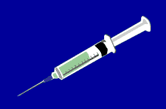
Step 1
Use the growth medium, which includes PCR primers, to make
billions of copies of a single gene.
|
|
Genetic vaccines, sometimes called naked-DNA vaccines, are
currently being developed to fight diseases such as AIDS. The
goal of these vaccines is to use a gene from a pathogen to
generate an immune response. A gene contains the instructions
to create a protein. With a genetic vaccine, small loops of
DNA in the vaccine invade body cells and incorporate
themselves into the cells' nuclei. Once there, the cells read
the instructions and produce the gene's protein.
Using a technique called PCR, which stands for polymerase
chain reaction, you'll make many copies of a specific gene.
The work of finding the gene and copying sequences of its DNA
is done by "primers."
|

Step 2
Combine the virus genes with vectors.
|
|
To make your genetic vaccine, you'll use vectors. Vectors are
agents that are able to enter and instruct cells to create
proteins based on the vector's DNA code. In this case, the
vectors are loops of double-stranded DNA. You can exploit the
vector's ability to create proteins by splicing a gene from
the virus into a vector. The cell that the vector later
invades will then produce proteins created by the virus.
The vectors and copied genes have been treated with
restriction enzymes, which are agents that cut DNA sequences
at known locations. The enzymes have cut open the round
vectors and trimmed the ends of the copied genes.
|

Step 3
Add bacteria to the vectors to allow the altered vectors to
replicate.
|
|
The ends of the vectors have again come together, but now with
a gene spliced into the loop. You'll need many copies of the
vector/gene loop for your genetic vaccine. These copies can be
produced with the help of bacteria.
Vectors are capable of self-replicating when within a
bacterial host, as long as that host is in an environment
conducive to growing. After you combine the vectors and
bacteria, the vectors will be shocked into the bacteria.
|

Step 4
Use the purifier to separate the altered vectors from the
bacteria.
|
|
The final vaccine should include only the vectors, so you'll
need to separate them from the bacteria after enough copies
have been produced. This can be done with a detergent, which
ruptures the cell walls of the bacteria and frees the DNA
within.
The relatively large bacterial DNA can then be separated from
the smaller DNA loop that makes up the vector.
|

Step 5
Fill the syringe with the altered vectors.
|
|
Upon inoculation, billions of copies of the altered vector
will enter the body. Of these, only 1 percent will work their
way into the nuclei of body cells. But that's enough.
The body's immune system responds to these proteins once they
leave the cell. But more importantly, it also reacts to
proteins that are incorporated into the cells' walls. So in
addition to mounting an attack against the free-floating
proteins, the immune system attacks and eliminates cells that
have been colonized by a pathogen. The vaccine, then, works
like a live vaccine, but without the risk. (With a live
vaccine, the pathogen can continue to replicate and destroy
cells as it does so.)
|

Done
The naked-DNA vaccine is complete.
Select another pathogen.
|
|
Congratulations. You have just produced a naked-DNA HIV
vaccine.
Trials for a genetic vaccine that may protect against AIDS
began in 1995. These vaccines, which contained HIV genes, were
given to patients who already were infected with HIV. A year
later, the trials were expanded to test people without HIV.
These trials are still being conducted and have not yet
produced conclusive results.
Human trials for genetic vaccines against herpes, influenza,
malaria, and hepatitis B are also underway.
Note: Although the genetic material of HIV is RNA, the
procedure for making the vaccine is similar.
|

